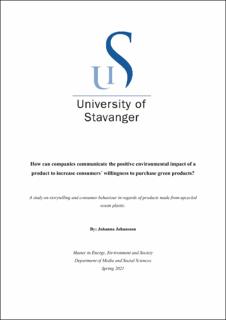| dc.description.abstract | This thesis investigates the role of storytelling in relation to a product made from upcycled ocean plastic. A quantitative survey was performed in cooperation with Ope AS which is leading a research project on upcycling ocean plastic. Through the project, Ope has produced their first product made out of 100% ownerless ocean plastic, and the survey was based on consumers’ willingness to pay that product. Two in-depth interviews of the founders of Ope were performed to get an insight into the idea behind using ocean plastic as material. This thesis takes a critical look at how we can replace the take-make waste practice with a closed loop. In a closed loop there is minimal waste and resources are used again and again. This thesis provides an overview of current literature on consumer on Circular Economy, green marketing and value creation, as well as theories on storytelling and consumer behaviour. Consumption is a big contributor to many environmental issues such as resource degradation, Co2 emissions and water shortage. Recycled material is available but is at a disadvantage when competing with cheap virgin material. The aim of this project was to see whether a non-material value can be added to a product through its positive environmental impact, and whether this added value can be communicated to consumers through storytelling. Environmental concern is rising among consumers, and this thesis argues that consumers can be part of the solution instead of the problem.
Based on the data and analysis presented, this thesis argues that there is a positive correlation between awareness and concern for the environment to green purchases. Storytelling proved to be an effective way of communicating a story, but only a certain group of respondents were influenced by the message. The data showed clear tendencies where those who expressed concerns for plastic pollution also displayed the highest increase in willingness to pay for the product. Based on the analysis, those who did not express an increased willingness to pay can be placed in two groups. Those who seem to be aware and concerned but did not trust that this product or this company would do anything to fix the problem, and those who did not seem to acknowledge that plastic in the ocean as a big problem. More research on what creates value, and how companies can communicate to consumers the added value that comes with a green product is required. When we buy products that are not “green”, nature is paying the price. If we include the benefits of the environment into the calculation, we can finally talk about the actual value of a product. | |
